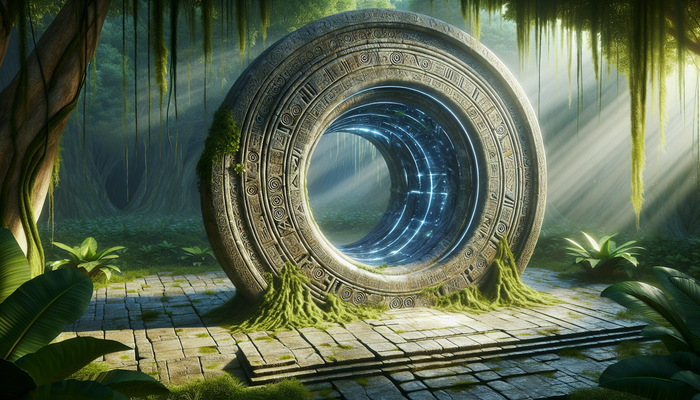Ancient Egyptian Alien Theories: Fact or Fantasy?

By Elaine Westfield, Ufologist
The Great Pyramid of Giza looms against the desert sky, its massive limestone blocks stacked with such precision that a credit card can't slip between them. Standing at nearly 500 feet tall and weighing approximately 6.5 million tons, this 4,500-year-old monument has sparked wonder for millennia. How did ancient Egyptians—without modern machinery, computers, or even simple wheels—construct something so monumental and precise?
For most archaeologists and historians, the answer lies in human ingenuity, remarkable organizational skills, and thousands of dedicated workers. But for a growing number of people worldwide, there's another explanation: extraterrestrial intervention.
"Aliens built the pyramids obv," tweeted tech billionaire Elon Musk in 2020, echoing a belief that has captured popular imagination since the mid-20th century. While his statement drew immediate rebuke from Egyptian officials and archaeologists, it highlighted the persistent appeal of these theories. According to Chapman University's Survey of American Fears, approximately 41% of Americans believe aliens visited Earth in ancient times—a percentage that continues to grow.
What makes these theories so compelling? Why do they focus so heavily on Egyptian monuments? And what does the archaeological evidence actually tell us? Let's separate fact from fantasy in the realm of ancient Egyptian alien theories.
From Science Fiction to Global Phenomenon
The idea that aliens built or helped design the pyramids didn't emerge from ancient texts or archaeological discoveries. Instead, it developed largely through science fiction and speculative literature of the late 19th and early 20th centuries.
After H.G. Wells published "The War of the Worlds" in 1897, a wave of Martian-themed science fiction captured public imagination. In 1898, Garrett P. Serviss published "Edison's Conquest of Mars," which specifically suggested the Great Pyramid and Sphinx were Martian constructions. Though clearly fictional, this story planted seeds that would later blossom into pseudoscientific theories.
The decisive turning point came in 1968 with Erich von Däniken's "Chariots of the Gods?"—a book that transformed vague speculation into a global movement. Von Däniken argued that various ancient structures, including the Egyptian pyramids, were too sophisticated for ancient civilizations to have built on their own. The book sold more than 65 million copies and kicked off decades of similar publications.
"It's not appreciating the skills and abilities of the people of the past," explains Professor Joyce Tyldesley of the University of Manchester. "Prior to the idea of aliens helping to build the pyramids, we had the idea that people from Atlantis might have helped, and prior to that we had the idea that God inspired the builders."
The theories gained further traction with mainstream media coverage. The National Enquirer serialized von Däniken's work in 1970, and in 1973, NBC aired an adaptation titled "In Search of Ancient Astronauts." But perhaps nothing has done more to popularize these ideas than the History Channel series "Ancient Aliens," which debuted in 2009 and continues today with over 200 episodes across more than 20 seasons.
The Great Pyramid: Cosmic Gateway or Pharaoh's Tomb?
At the heart of ancient Egyptian alien theories is the Great Pyramid of Giza—Egypt's crown jewel and the last remaining wonder of the ancient world. Built during the Fourth Dynasty as a tomb for Pharaoh Khufu (around 2560 BCE), its construction achievements seem almost superhuman.
Ancient astronaut theorists point to several features they claim suggest extraterrestrial influence:
- Precision alignment: The Great Pyramid is aligned to true north with an accuracy of 3/60th of a degree—a level of precision that, according to "Ancient Aliens," is "more accurate than any other structure on Earth." How could ancient Egyptians achieve this without advanced technology?
- Mathematical relationships: The pyramid allegedly contains sophisticated mathematical knowledge, with measurements that correspond to the Earth's dimensions, astronomical values, and even the speed of light. David Wilcock claims on "Ancient Aliens" that the Great Pyramid demonstrates "technological sophistication far in excess of anything that we have today."
- Eight-sided design: When viewed from above during the spring and autumn equinoxes, the Great Pyramid reveals it actually has eight sides rather than four—a subtle design element only visible from the air at specific times.
- Construction challenges: Moving and precisely placing stones weighing up to 80 tons seems impossible without advanced technology. As Robert Bauval asks on "Ancient Aliens": "If you want to build a tomb, fair enough. Why use 2 and 1/2 million blocks of stones?"
- The Orion correlation: The three main pyramids at Giza allegedly mirror the three stars of Orion's Belt, suggesting a cosmic connection. Some theorists claim this alignment was most precise around 10,500 BCE—far earlier than conventional dating.
- Energy generation: Some ancient astronaut theorists suggest the pyramids weren't tombs at all but sophisticated power plants or energy generators. Christopher Dunn's 1998 book "The Giza Power Plant" proposes the Great Pyramid was designed to harness energy through resonant frequencies.
While these claims might sound compelling at first, archaeologists have solid explanations for each. The pyramid's alignment could be achieved through careful astronomical observation. The apparent mathematical relationships are largely coincidental—just as astrophysicist Cornelius de Jager demonstrated when he found similar "meaningful" mathematical relationships in the measurements of a bicycle.
"Coincidences occur regularly in numerical experiments, as in daily life," de Jager noted. "Most people greatly underestimate the enormous amount of possible combinations between numbers."
The Great Sphinx: Guardian of Alien Secrets?
The Great Sphinx, with its human head and lion's body, presents another focus for ancient alien theories. Located near the pyramids on the Giza plateau, this massive monolith has weathered millennia of desert storms and human interest.
Ancient astronaut theorists highlight several aspects of the Sphinx they find suspicious:
- Weathering patterns: Some researchers, most notably geologist Robert Schoch, suggest vertical erosion patterns on the Sphinx indicate water damage—implying it was built thousands of years earlier when the region received significant rainfall (around 10,000 BCE). This would predate known Egyptian civilization and, according to ancient alien theorists, suggests extraterrestrial influence.
- The Dream Stele: Between the paws of the Sphinx lies a granite tablet placed by Pharaoh Thutmose IV around 1400 BCE. It tells the story of how the Sphinx—then buried up to its neck in sand—spoke to Thutmose in a dream, promising him the throne if he cleared away the sand. "Ancient Aliens" interprets this as evidence of alien technology, referring to "the flashing eye of the lord" mentioned in the text as "some kind of technology that is in communication with the Sphinx."
- Hidden chambers: Some theories suggest secret chambers beneath the Sphinx contain advanced technology or historical records from extraterrestrial visitors. Psychic Edgar Cayce predicted a "Hall of Records" containing the history of Atlantis would be found under the Sphinx's right paw.
Despite decades of investigation using ground-penetrating radar and seismic surveys, no significant chambers have been discovered beneath the Sphinx. The weathering patterns can be explained by typical erosion processes acting on the limestone over thousands of years, and the Dream Stele represents standard Egyptian religious narratives rather than alien technology.
Underground Marvels: The Serapeum Mystery
Among the less famous but equally intriguing sites cited by ancient astronaut theorists is the Serapeum at Saqqara. Discovered in 1850 by French Egyptologist Auguste Mariette, this underground complex contains 24 massive stone sarcophagi, each weighing between 70-100 tons.
The sheer size and precision of these boxes have led Giorgio Tsoukalos to call the Serapeum "one of the most inexplicable places on planet Earth." He questions how ancient Egyptians could have transported these enormous structures through narrow passageways and carved them with such precision.
"They are incredibly heavy," Tsoukalos says. "The bottom parts are estimated to weigh between 70 to 75 metric tons. The lids are estimated to weigh between 20 and 25 metric tons... And the workmanship with which these sarcophagi have been created is absolute perfection."
Conventional archaeology explains these boxes were created to house the mummified remains of sacred Apis bulls. However, ancient astronaut theorists point out that only one contained any animal remains, leading them to suggest the boxes might have served some technological purpose or even contained alien beings.
Akhenaten: The "Alien" Pharaoh
The 18th Dynasty Pharaoh Akhenaten (who ruled from approximately 1353-1336 BCE) stands out in Egyptian history for two reasons: his radical religious reforms that replaced Egypt's traditional pantheon with worship of a single deity, the Aten (represented as a sun disk); and his unusual physical appearance in artwork.
Ancient astronaut theorists find Akhenaten particularly fascinating because artwork depicts him with an elongated skull, slim neck, wide hips, and protruding belly—features markedly different from idealized portrayals of other pharaohs. His wife Nefertiti and their children are similarly portrayed with elongated heads.
"I mean, he's got a very narrow, pointy face, high cheekbones, and a very elongated cranium," Tsoukalos notes on "Ancient Aliens." Others on the show suggest Akhenaten might have been an extraterrestrial hybrid or possessed alien DNA.
The worship of the Aten—depicted as a sun disk with rays ending in hands—is interpreted by some ancient astronaut theorists as worship of a spacecraft or some form of extraterrestrial technology that Akhenaten had witnessed.
Adding to the mystery, Akhenaten's mummy has never been conclusively identified, which some cite as evidence that he might have returned to the stars with his extraterrestrial brethren.
Medical experts offer a more grounded explanation: Akhenaten likely suffered from a genetic disorder such as Marfan syndrome, which causes elongated features. His artistic depictions also reflect a deliberate stylistic change that symbolized his religious reforms rather than his actual appearance.
How the Pyramids Were Actually Built
While ancient alien theorists claim building the pyramids would have been impossible for ancient Egyptians, archaeological evidence reveals a rich history of how these monumental structures were actually created.
The Great Pyramid didn't appear suddenly without precedent. Archaeologists have documented a clear evolution of pyramid building in Egypt:
- Simple mastaba tombs with flat roofs and sloped sides
- The Step Pyramid of Djoser (around 2630 BCE), designed by architect Imhotep
- The Bent and Red Pyramids at Dahshur, showing experimentation with angles
- Finally, the Great Pyramid of Khufu, representing the culmination of decades of architectural development
Recent archaeological discoveries have revealed fascinating details about construction methods:
- Quarrying: Evidence of ancient quarries exists near pyramid sites, complete with tool marks showing how stones were cut using copper saws and dolerite balls for pounding.
- Transportation: In 2018, archaeologists at Hatnub quarry discovered a steep ramp with post holes on either side, suggesting an advanced pulley system that would have allowed workers to move heavy blocks up steep inclines. As Egyptologist Dr. Nicky Nielsen explains: "Pulleys. They could pull very heavy blocks up a very steep gradient using pulleys and a ramp."
- Water transport: Papyri discovered at the ancient port of Wadi al-Jarf document how limestone blocks were transported via boats on the Nile—solving the mystery of how stones from distant quarries reached Giza.
- Workforce organization: Remains of workers' villages near the pyramids reveal sophisticated organization, including evidence of medical care for injured workers, food distribution systems, and carefully planned housing areas.
Marks on stones indicate they were numbered for placement, revealing thoughtful logistics rather than alien technology. The internal ramps archaeologists believe were used to raise stones have been lost to time, but evidence of their existence remains in the pyramid structure.
The Psychology Behind the Belief
Why do ancient Egyptian alien theories remain popular despite overwhelming archaeological evidence? The answer lies partly in human psychology and how we make sense of the world.
When confronted with impressive ancient achievements, our first instinct is often wonder—followed by questions about how such feats were possible. As archaeologist Dr. Matthew Peeples notes, "It's not appreciating the skills and abilities of the people of the past because we have sufficient evidence to show that these people could do this type of building."
Several psychological factors contribute to the popularity of these theories:
- Pattern recognition: Humans excel at finding patterns, sometimes seeing meaningful connections where none exist (a phenomenon called apophenia). The alleged mathematical encodings in the Great Pyramid exploit this tendency.
- Cognitive dissonance: When faced with incomplete historical information, some people prefer extraordinary explanations to uncertainty.
- Distrust of authority: Rejection of academic expertise appeals to those who distrust established institutions, with ancient astronaut theorists often claiming archaeologists are hiding the "truth."
- Media influence: Shows like "Ancient Aliens" use rhetorical techniques that science writer Riley Black describes as a "Gish gallop" that "overwhelm[s] the viewer with many 'fictions and distortions.'" The repetition of these ideas creates an "illusory truth effect," where familiar claims begin to feel true regardless of evidence.
The Unintended Racism of Alien Architecture
While most ancient astronaut theorists don't consider themselves racist, many scholars point out that these theories contain troubling racial undertones. By suggesting ancient Egyptians couldn't have built their monuments without extraterrestrial help, they implicitly diminish the achievements of non-Western civilizations.
"You see [pseudoarchaeology] principally applied to places that are exoticized, like Peru, Native American civilizations, Meso-America, Egypt, India," notes Professor Thomas Landvatter. "Civilizations that are perceived on the one hand as very advanced by modern observers, but on the other hand viewed as so primitive as to cast doubt on their having accomplished anything on their own."
Dr. Nicky Nielsen observes a telling double standard: "Aside from Stonehenge, European ancient monuments aren't dragged into the whole Ancient Aliens debate, like the Colosseum, even though it's clearly a massive work of construction. It removes agency from indigenous cultures, and it takes their ownership of their own history away from them."
Egyptian archaeologist Zahi Hawass responded forcefully to Elon Musk's 2020 tweet claiming aliens built the pyramids, calling it a "complete hallucination." For modern Egyptians, these theories effectively rob them of their cultural heritage by suggesting their ancestors were incapable of creating their civilization's most impressive achievements.
As Dr. Julien Benoit of the University of the Witwatersrand states, these theories "perpetuate and give air to the racist notion that only Europeans—white people—ever were and ever will be capable of such architectural feats."
The Wonder of Human Achievement
The true story of how ancient Egyptians built the pyramids is far more impressive than alien intervention. It speaks to human ingenuity, determination, and our capacity for remarkable achievements through collective effort.
The pyramids represent the culmination of generations of architectural knowledge, the organization of massive workforces, sophisticated logistics, and precise astronomical observations—all without modern technology. The gradual evolution of pyramid design shows a learning process of trial and error that led to the perfection of the Great Pyramid.
As Dr. Nicky Nielsen concludes: "People will always have an alternative idea instead of accepting that non-Europeans are capable of building monumental architecture, which is, after all, the easiest explanation: the pyramids were built by the Egyptians. Because they were there."
Rather than diminishing our sense of wonder, this human origin makes the pyramids even more impressive. They stand as monuments to what our species can accomplish through intelligence, organization, and determination—a testament to human potential that continues to inspire awe more than 4,500 years after their creation.
The ancient Egyptians didn't need aliens to build their magnificent civilization. They had something equally powerful: human ingenuity, accumulated knowledge passed through generations, and the ability to organize collective efforts toward astonishing achievements.
In the end, that human story—of striving, learning, creating, and leaving behind works that stand for millennia—is far more remarkable than any extraterrestrial intervention.
From Bigfoot to UFOs: Hangar 1 Publishing Has You Covered!
Explore Untold Stories: Venture into the world of UFOs, cryptids, Bigfoot, and beyond. Every story is a journey into the extraordinary.
Immersive Book Technology: Experience real videos, sights, and sounds within our books. Its not just reading; its an adventure.


























